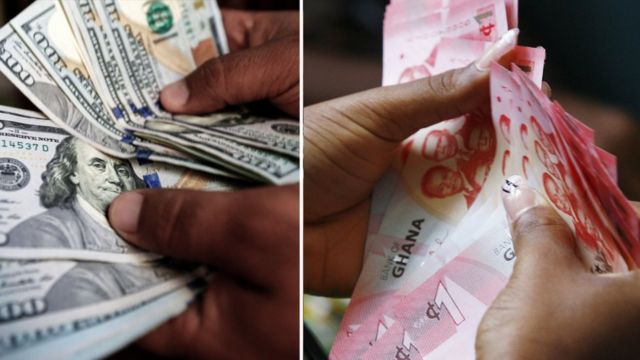Cedi: local currency struggles to stabilize against greenback despite BoG support
The Ghana Cedi is still struggling to stabilize against the US Dollar despite increase in Bank of Ghana support and influx of holiday makers.
In terms of average cost by some of the major commercial banks in the country, the cedi has moved from around ¢6.30 to about ¢6.42 in just about a week.
The challenge is purely a supply and demand issue, so if demand picks up and there is not enough supply, the cedi will definitely come under some pressure.
Checks by some of the banks show that the Bank of Ghana has indeed been inactive on the market in terms of dollar supply.
However, emittances have also picked up as well as holiday makers from abroad have brought in some dollars.
It was expected that these inflows should have helped slow the rate of depreciation of the cedi, however, it appears this has not helped that much.
A careful look at the forward sale of dollars by the BoG shows that demand is still high, for instance, the recent auction result showed that whiles the Bank of Ghana was willing to offer about $40 million, request from other banks and businesses stood at $170 million.
However, some market analyst believe that the Bank of Ghana may have to do more in terms of the amount of dollars that is supplied unto the market.
The cedi has come under some pressure over the past two months due to the decision of some offshore investors to sell their bonds because of some fiscal issues and as well as demand for dollars by businesses to finance their imports picking up strongly.
Some economists have also argued that this current challenge if not contained, could end up eroding the gains made so far.
Meanwhile, the cedi has recorded yet another high depreciation rate against the dollar as the demand for the greenback by importers increase ahead of the Christmas festivities.
The daily interbank FX rates data published by the Bank of Ghana indicates that the cedi is currently trading at GH¢5.7602 (mid-rate) to $1, revealing the local currency has depreciated by 3.2 percent as of December 21 from the 2.6 percent depreciation it recorded at the end of November.
The central bank attributed the fall to the decisions of some foreign investors to pull out due to debt sustainability concerns and also the rising demand for FX by importers.
Taking the fall from a historical perspective, the cedi depreciation against the dollar ahead of the festive season is quite normal, since same was recorded the previous year with 3.1 percent, 3.2 percent and 3.9 percent fall in October, November and December respectively.
“Increased concerns about strength of the recovery and the stronger US dollar have exerted currency pressures in some emerging market and frontier economies. Consequently, policy rates in some emerging market countries have been hiked to counter rising inflation.
“The country’s sovereign bond spreads widened markedly over the period as investor sentiments shifted based on fiscal and debt sustainability concerns, prompting some sell-offs by investors with spillovers on the domestic foreign exchange market. This triggered some currency pressures in the past two months as demand for the U.S. dollar increased,” the Monetary Policy Committee (MPC) statement said.








